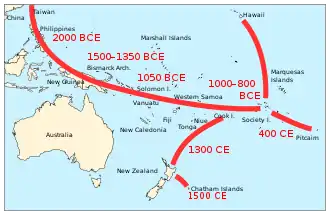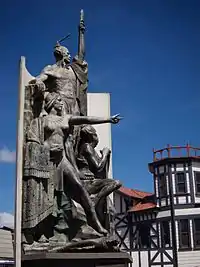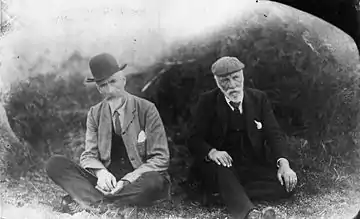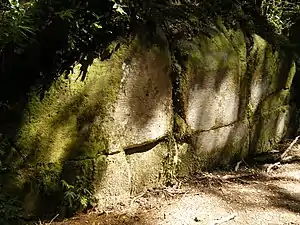Pre-Māori settlement of New Zealand theories
Since the early 1900s the theory that Polynesians (Māori) were the first ethnic group to settle in New Zealand (first proposed by Captain James Cook) has been dominant among archaeologists and anthropologists.[1][2] Before that time and until the 1920s, however, a small group of prominent anthropologists proposed that the Moriori people of the Chatham Islands represented a pre-Māori group of people from Melanesia, who once lived across all of New Zealand.[3] While this idea lost favour among academics, it was widely published and incorporated into school textbooks which has extended its life in the popular imagination.[4][5][6]

Some early visitors to New Zealand did speculate that the original New Zealanders might be descended from ancient Greeks, Romans or Egyptians, and some Christian missionaries thought that the Māori ancestors belonged to the lost tribes of Israel.[7] In more recent times, outside of academia a similar variety of speculation of New Zealand's first settlers has occurred. These ideas typically incorporate aspects of conspiracy theories as they are in opposition to the last 100 years of academic research.[8][9]
Māori oral traditions

Māori oral tradition provides a sort of backbone for pre-Māori theories which sometimes cite the now-discredited Great Fleet hypothesis. More remote traditions speak of all manner of spirits, fairy folk, giants, and ogres living in parts of New Zealand when Māori arrived. The pale-skinned patupaiarehe are perhaps the most well-known, which Ngāti Kura, Ngāti Korakorako, and Ngāti Tūrehu are said to be sub-groupings of.[10][11] In oral tradition, patupaiarehe taught weaving and net-making to the Māori, and could not come out during the day.[12][13] Ponaturi were similar in that they could not tolerate sunlight, so they lived in the ocean.[11]
In south Westland, Kāti Māhaki ki Makaawhio's Te Tauraka Waka a Maui Marae[14] is named in honour of a tradition stating that Māui landed his canoe in Bruce Bay when he arrived in New Zealand.[15] In a myth collected from Lake Ellesmere / Te Waihora, Māui threw a giant to the sea and buried him underneath a mountain to create the area around Banks Peninsula.[16] A well-known story is how Māui fished up the North Island out of the Pacific Ocean, which Te Rangi Hīroa of Ngāti Mutunga suggests might be a way to say he 'discovered' the island out of the blue, though the rest of the myth is very fanciful in saying parts of his canoe became different areas of both islands.[17]
In the traditions of Ngāi Tahu's Waitaha descendants, Rākaihautū of the Uruaokapuarangi was the first man to set foot in the South Island by digging up the many lakes and waterways and filling them with fish. He brought with him the ancestors of the groups Te Kāhui Tipua, Te Kāhui Roko, and Te Kāhui Waitaha.[18][19] According to Sir Āpirana Ngata of Ngāti Porou, Rākaihautū did not go south at all, but rather his legend was brought down there.[20] Some accounts may say he is an ancestor of Toi through a daughter that stayed behind in Te Patunuioāio, who himself is an ancestor of Kāti Māmoe, Te Kāhea, Ngāpuhi, Ngāti Rāhiri Tumutumu, and Hāwea in some tellings.[21] Hāwea might have alternatively been a different tribe that arrived on the Kapakitua before or at a similar time to Waitaha before merging with them, with other ancient tribal groupings possibly including the Maero and Rapuwai.[22][23]
In Ngāi Tūhoe traditions, Toi's 'ancestor' Tīwakawaka was the first to settle the country aboard Te Aratauwhāiti, "but only his name is remembered".[24] A man named Kahukura took Toi's own canoe, the Horouta, and returned to Hawaiki. He sent kūmara back to the new lands with the canoe,[25] which in Ngāti Kahungunu traditions was accompanied by Kiwa, who later sailed around to Gisborne and became the first man there.

Kupe and Ngahue were both contemporaries famous for exploring New Zealand before notable migration voyages began.[26] The latter discovered pounamu,[27] the former introduced the first dogs (kurī) and created Lake Grassmere/Kapara Te Hau to drown Te Kāhui Tipua - who were described as 'giants' or 'ogres' living in Marlborough at the time.[28] Both Kupe and Ngahue returned to Hawaiki,[24] though Ngahue came back with the Arawa after a war with Uenuku.[29]
In tradition, the local Ngāti Hotu and Ngāti Ruakopiri of Lake Taupo and Lake Rotoaira were harassed by Ngāti Tūwharetoa,[30] and later pushed to extinction in the King Country by the Whanganui Māori.
Early European speculation

During the 19th century, ideas about Aryan migrations became popular and these were applied to New Zealand. Edward Tregear's The Aryan Maori (1885) suggested that Aryans from India migrated to southeast Asia and thence to the islands of the Pacific, including New Zealand.[32]
The writing of Percy Smith and Elsdon Best from the late 19th century theorised about pre-Māori settlement. Their work inspired theories that the Māori had displaced a more primitive pre-Māori population of Moriori (sometimes described as a small-statured, dark-skinned race of possible Melanesian origin), in mainland New Zealand – and that the Chatham Island Moriori were the last remnant of this earlier race.[3] Julius von Haast echoed this idea, suggesting an early nomadic people, who subsisted mainly on moa hunting and beachcombing, were superseded by the Māori who introduced agriculture and lived in small villages.[33]
Recent revivals of pre-Māori settlement theories

Although modern New Zealand archaeology has largely clarified questions of the origin and dates of the earliest migrations, some theorists have continued to speculate that what is now New Zealand was discovered by Melanesians, 'Celts', Greeks, Egyptians or the Chinese, before the arrival of the Polynesian ancestors of the Māori.[34][35] Some of these ideas have also been supported by politicians and media personalities.[6][36][37]
An earlier presentation of the theory of pre-Polynesian European settlement of New Zealand was Kerry Bolton's 1987 pamphlet Lords of the Soil,[38] which states that "Polynesia has been occupied by peoples of the Europoid race since ancient times".[39]
Other books presenting such theories have included The Great Divide: The Story of New Zealand & its Treaty, (2012) by Ian Wishart, a journalist, and To the Ends of the Earth by Maxwell C. Hill, Gary Cook and Noel Hilliam, which claims that New Zealand was discovered by explorers from ancient Egypt and Greece.[40]
Historians and archaeologists dismiss the theories. Michael King wrote in his history of New Zealand, "Despite a plethora of amateur theories about Melanesian, South American, Egyptian, Phoenician and Celtic colonisation of New Zealand, there is not a shred of evidence that the first human settlers were anything other than Polynesian",[41] and Richard Hill, professor of New Zealand Studies at Victoria University of Wellington, said in 2012, "Not one of [the theories] has ever passed any remote academic scrutiny."[42] Hugh Laracy of the University of Auckland called them "wild speculation" that has been "thoroughly disposed of by academic specialists".[43]
Another historian, Vincent O'Malley, and the New Zealand Archaeological Association regard the theories as having a racist or at least a political element, seeking to cast doubt on Waitangi Tribunal claims.[42][44] Scott Hamilton in "No to Nazi Pseudo-history: an Open Letter" further explains objections to the theories of Bolton and Martin Doutré (and the website Ancient Celtic New Zealand).[45]
Places

A site frequently related by theorists as evidence of pre-Polynesian settlers is the Kaimanawa Wall, which some claim is a remnant of ancient human construction that the Māori could not have built because they did not build with stone in such a way.[46][47][48] Controversial author Barry Brailsford claimed that 'Waitaha elders' said it was built before their arrival.[49][50][lower-alpha 1] Several anthropologists and geologists have concluded the formation to be a natural ignimbrite outcrop formed 330,000 years ago.[46][47][48][51] A ground-penetrating radar scan of the area surrounding the formation confirmed that it is not part of a pyramid as the rock has no regularities or chambers for a depth of 12 metres, and no metal had been found under a geomagnetic scan.[52]
Boulders originally on a hill in Silverdale, Auckland have been argued by Martin Doutré in a 1999 book to be artefacts left by a pre-Polynesian Celtic population, who according to the theory came to be known as the patupaiarehe, and used the boulders as part of a system spanning around the area, used for calendar tracking and survey functions.[53] Bruce Hayward, a Geological Society spokesman, says the boulders were formed in the ocean 70 million years ago and naturally pushed into the hills over time.[54] The Moeraki Boulders are another patch of boulders which are found on the Koekohe Beach in Otago.
Other supposed structures and creations of pre-Polynesian settlers are described as the Waipoua 'stone city',[55] the 'Waitapu Valley (Maunganui Bluff) solar observatory' including Puketapu hill and a mountain at Hokianga, a 'stone village' in the Tapapakanga Regional Park, and all manner of petroglyphs and carvings found throughout the islands. Most of these ideas are propounded by Doutré.[55]
'White people'
David Rankin, a Ngāpuhi elder, has drawn attention to Māori legends suggesting that people, some of them with fair skin, were already present in the islands when Polynesians arrived,[56] and has claimed the existence of a conspiracy among academics to suppress inquiry.[43] In his theories, he draws on ideas from Ian Wishart and Maxwell Hill.[42]
Theorists commonly point to one Mrs Matamua as a source of evidence that pale-skinned Māori with golden hair and green eyes did and do exist. Mrs Matamua claims to be one of roughly 2,000 living descendants of Ngāti Hotu (as well as of Ngāti Maru, Ngāti Tūwharetoa, and Whanganui Māori),[57] further claiming the group's ancestors left Iran[58][59] through Borneo[57] long ago. After taking a DNA test with the National Geographic Society's Genographic Project,[60][lower-alpha 2] her maternal haplogroup has been identified as B4, and her regional results turned up 28% northeast Asian, 20% southeast Asian, 18% Oceanian, 12% northern European, 12% Mediterranean, 6% Sub-Saharan African, and 4% southwest Asian, and her reference populations were to the Vietnamese and Puerto Ricans.[58] Mrs Matamua additionally claims that Ngāi Tūhoe "are of Ngāti Hotu."[59]
Theorists may claim that Persians were exiled from the area west of India to Peru after sailing around southern Africa, only to be chased out again to Rapa Nui with Hotu Matuꞌa being their leader at the time, and then spreading out into the rest of Polynesia, thus ending up with a Pre-Māori group that had been chased half-way around the world to ultimately settle in New Zealand.[59][lower-alpha 3] A study published to the Nature journal by Stanford University on 8 July 2020 concluded that around roughly 1150–1230 AD a 'single shared contact event' had taken place between Polynesians and coastal Colombian Amerindians before the settlement of Rapa Nui.[62] The study analysed 807 individuals from 17 island populations and 15 Pacific coast indigenous American groups,[63] with the earliest admixture having been found in the southern Marquesas Islands, which seemingly spread to the nearby islands and eventually reached Rapa Nui by 1380 AD.[64] Future research will be needed to assess the possibility that there may have been more contact events, and explore other alternative hypotheses.[64]
'Giant' skeletons such as a decayed specimen found 7 feet below sand at the Saltwater Creek spit in Otago during 1875[65][66] and a stone adze next to a tree stump that was reportedly discovered 25 feet underground in Auckland during March 1874[67][68] are cited as further examples of ancient, forgotten history. T. H. Cockburn-Hood seemed to suggest in 1874 that the volcanic layers that the stump was found under had been deposited from Rangitoto[69] leading some to believe that the stump and adze were at least 30,000 years old,[70] though more recent research concludes that Rangitoto is only about 600 years old.[71] Alleged giant skeletons are attributed to folkloric beings, such as the Maero or Te Kāhui Tipua.[65]
References
Notes
- This is technically correct, as the stone was still shaped that way before Māori arrived regardless of whether it formed naturally or somebody built it.
- Based on the publication date of the elocal magazine, Mrs Matamua likely took the test in or around 2013,[58] when the project was still in its earlier '1.0' phase.[61]
- Mrs Matamua initially claimed this for her own ancestors,[56][59] but in a more recent issue of the elocal magazine she now appears to believe her ancestors came through Borneo instead of Peru.[57]
Citations
- See 1904 paper by A. Shand on The Early History of the Morioris
- Shapiro, HL (1940). "The physical anthropology of the Maori-Moriori". The Journal of the Polynesian Society. XLIX (1(193)): 1–15. JSTOR 20702788.
- "Imagining Moriori: A history of ideas of a people in the twentieth century", Jacinta Blank, MA Thesis, 2007
- For example The Cyclopedia of New Zealand of 1902
- "Imagining Moriori: A history of ideas of a people in the twentieth century", Jacinta Blank, MA Thesis, 2007
- "Don Brash - Ragging on Te Reo". Radio New Zealand. 2 December 2017. Retrieved 15 December 2018. Time=30:20
- K. R. Howe. p 1 'Ideas about Māori origins', Te Ara: The Encyclopedia of New Zealand, published 8 February 2005
- "Moriori myth corrected". Stuff. Retrieved 16 December 2018.
- "TVNZ doco claiming Celts were here before Māori has been removed from OnDemand service". Stuff. Retrieved 16 December 2018.
- Royal, Te Ahukaramū Charles (2005). "First peoples in Maori tradition: Patupaiarehe, Turehu and other inhabitants". Te Ara Enyclopedia of New Zealand. Retrieved 28 June 2020.
- Wikaira, Martin (2007). "Patupaiarehe and ponaturi". Te Ara Enyclopedia of New Zealand. Retrieved 28 June 2020.
- Hindmarsh, Gerard. "Flax - the enduring fibre". New Zealand Geographic. Retrieved 13 June 2020.
- Tregear, Edward (1891). The Maori-Polynesian comparative dictionary. Wellington: Lyon and Blair. Retrieved 13 June 2020.
- "Te Rūnanga o Makaawhio contact page". Te Rūnanga o Makaawhio. Retrieved 13 June 2020.
- "Bruce Bay". Westland District Council. Retrieved 13 June 2020.
- "Horomaka or Te Pataka o Rakaihautū — Banks Peninsula". Christchurch City Libraries. Retrieved 11 June 2020.
- Hīroa, Te Rangi (1976) [1949]. The Coming of the Maori (Second ed.). Wellington: Whitcombe and Tombs. p. 5. ISBN 0723304084.
- "Kōrero Tuku Iho - Our History". Te Taumutu Rūnanga. Retrieved 28 June 2020.
- "Rākaihautū". University of Canterbury. Retrieved 28 June 2020.
- Ngata, A. T. (1950). Grace, John Te Herekiekie (ed.). "The Io Cult - early migration - puzzle of the canoes)". The Journal of the Polynesian Society. LIX: 338. Retrieved 28 June 2020.
- Graham, George (1922). "Te heke-o-nga-toko-toru. (The migration of the three.)". The Journal of the Polynesian Society. XXXI. Retrieved 28 June 2020.
- Stephenson, Janet; Bauchop, Heather; Petchey, Peter (2004). "Bannockburn Heritage Landscape Study" (PDF). Retrieved 12 June 2020.
- "Ancient Iwi". Ngāi Tahu. Retrieved 28 June 2020.
- Biggs, Bruce Grandison (1966). "Tradition". In McLintock, A. H. (ed.). Maori Myths and Traditions. Wellington: Government Printer. p. 450. Retrieved 11 June 2020.
- Rāwiri, Taonui (2005). "Canoe traditions: Canoes of the East Coast". Te Ara Enyclopedia of New Zealand. Retrieved 28 June 2020.
- Taonui, Rāwiri (2005). "Canoe traditions: Greenstone adze". Te Ara Encyclopedia of New Zealand. Retrieved 12 June 2020.
- Best, Elsdon (1934). "Voyage of Kupe and Ngahue from Eastern Polynesia to New Zealand". The Maori As He Was: A Brief Account of Maori Life as it was in Pre-European Days. Wellington: N.Z.Dominion Museum. p. 22.
- Mitchell, Hilary; Mitchell, John (2005). "Te Tau Ihu tribes: Early Traditions". Te Ara Encyclopedia of New Zealand. Retrieved 12 June 2020.
- Tapsell, Paul (2005). "Te Arawa: Origins". Te Ara Encyclopedia of New Zealand. Retrieved 12 June 2020.
- Orbell, Margaret (June 1966). "Review of Tuwharetoa by John Te H. Grace'". Te Ao Hou (55): 63. Retrieved 29 June 2020.
- Photograph by kind permission of the Alexander Turnbull Library, Wellington, New Zealand, reference number: 1/2-028237-F
- K. R. Howe. p 2 'Ideas of Māori origins', Te Ara: The Encyclopedia of New Zealand, updated 9 Nov 12
- Page 4. 1880s–1970s: Moriori origins; the Great Fleet', Te Ara: The Encyclopedia of New Zealand, updated 9 Nov 12
- Noted. "Did the Spanish or Chinese visit New Zealand before Polynesians? - The Listener". Noted. Retrieved 2 February 2019.
- "1 The Waitaha People – a Chinese colony that settled in New Zealand 2000 years ago. | The Lost Empire of Atlantis | 1421 | 1434 | Chinese Exploration | Gavin Menzies". Retrieved 2 February 2019.
- "History in the Making | NZCPR Site". www.nzcpr.com. Retrieved 2 February 2019.
- Keir, Bill (31 January 2007). "Agenda-driven history". NZ Skeptics. Retrieved 2 February 2019.
- Kerry R. Bolton (1987). Lords of the Soil. Petone: Realist Publications. OCLC 154233606.
- Barrie Sargeant (2 December 2004). "Kerry Bolton — a nut, or just a misunderstood Mormon/Satanist/Nazi?". Fightdemback. Archived from the original on 14 April 2013. Retrieved 13 February 2013.
- The Great Divide: The Story of New Zealand and its Treaty. Auckland: Howling at the Moon. 2012. ISBN 9780987657367. Maxwell C. Hill (2012). To the Ends of the Earth. Taupiri: Ancient History Publications. ISBN 9780473206871. "Book claims European explorers were here first". 3 News. 23 March 2012.
- Michael King (1994). The Penguin History of New Zealand. Penguin Books. p. 29. ISBN 978-0-14-301867-4.
- Rebecca Quilliam (27 December 2012). "Historians rubbish claims of academic conspiracy". The New Zealand Herald.
- "Stoush over pre-Maori colonisers theory". Stuff.co.nz, Fairfax NZ News. 28 December 2012.
- "Alternative Archaeology". New Zealand Archaeological Association. Retrieved 12 February 2013.
- Scott Hamilton (18 November 2008). "No to Nazi Pseudo-history: an Open Letter". Scoop Review of Books.
- Ritchie, Neville (1996). "A New Age Myth: the Kaimanawa Wall". NZ Skeptics. Retrieved 28 June 2020.
- Howe, K. R. (2005). "Ideas about Māori origins: The Kaimanawa Wall". Te Ara Enyclopedia of New Zealand. Retrieved 28 June 2020.
- "Kaimanawa wall - New Zealand". Ancient Origins. 2013. Retrieved 29 June 2020.
- "The Mystery of the Kaimanawa Wall - Part One". YouTube.com. 15 February 2017. Retrieved 30 June 2020.
- "New Zealand's Kaimanawa Wall - cornermystery.com". YouTube.com. 29 June 2019. Retrieved 30 June 2020.
- "Kaimanawa Wall Formation sign". Department of Conservation.
- "The Mystery of the Kaimanawa Wall - Part Two". YouTube.com. 29 June 2019. Retrieved 29 June 2020.
- Martin Doutré (1999). Ancient Celtic New Zealand. Auckland: Dé Danann Publishers. ISBN 9780473053673. Wayne Thompson (6 May 2009). "Call to save hilltop boulders". The New Zealand Herald.
- Wayne Thompson (6 May 2009). "Call to save hilltop boulders". The New Zealand Herald.
- Hamilton, Scott (22 May 2017). "The white tangata whenua, and other bullshit from the 'One New Zealand' crew". TheSpinoff. Retrieved 30 June 2020.
- "DNA To Rock The NATION! part 3". elocal. January 2014.
- "One Woman's Battle for Recognition of Ngāti Hotu". elocal (Digital ed.). May 2020. pp. 18–23. Retrieved 29 June 2020.
- "DNA To Rock The NATION! part 2". elocal. January 2014.
- Gabi Plumm, Peter Marsh (17 November 2015). The Redheads. Skeletons in the Cupboard.
YouTube title: Redheads Part 1 of Skeletons in the Cupboard series
- "DNA To Rock The NATION! part 1". elocal. January 2014.
- "The Genographic Project". National Geographic. 28 June 2018. Retrieved 30 June 2020.
- Ioannidis, Alexander G.; Blanco-Portillo, Javier; Sandoval, Karla; Hagelberg, Erika; Miquel-Poblete, Juan Francisco; Moreno-Mayar, J. Víctor; Rodríguez-Rodríguez, Juan Esteban; Quinto-Cortés, Consuelo D.; Auckland, Kathryn; Parks, Tom; Robson, Kathryn; Hill, Adrian V. S.; Avila-Arcos, María C.; Sockell, Alexandra; Homburger, Julian R.; Wojcik, Genevieve L.; Barnes, Kathleen C.; Herrera, Luisa; Berríos, Soledad; Acuña, Mónica; Llop, Elena; Eng, Celeste; Huntsman, Scott; Burchard, Esteban G.; Gignoux, Christopher R.; Cifuentes, Lucía; Verdugo, Ricardo A.; Moraga, Mauricio; Mentzer, Alexander J.; Bustamante, Carlos D.; Moreno-Estrada, Andrés (8 July 2020). "Native American gene flow into Polynesia predating Easter Island settlement". Nature. Retrieved 13 July 2020.
- Daly, Michael (10 July 2020). "Genetic study finds Polynesian encounter with Native Americans 800 years ago". Stuff. Retrieved 13 July 2020.
- Wallin, Paul (8 July 2020). "Native South Americans were early inhabitants of Polynesia". Nature. Retrieved 13 July 2020.
- "Timaru Herald from New Zealand 1875 reports of Giants Remains". Greater Ancestors world Museum. 2011. Retrieved 28 June 2020.
- "Untitled". Timaru Herald. XXII (1169). 24 February 1875. Retrieved 28 June 2020.
- "Sidestep: Stumped for answers". 2018. Retrieved 28 June 2020.
- "Interesting Discovery". Hawke's Bay Times (1560). 20 March 1874. Retrieved 28 June 2020.
- Cockburn-Hood, T. H. (1874). "Art. VIII.—Notes upon the probable Changes that have taken place in the Physical Geography of New Zealand since the Arrival of the Maori". National Library of New Zealand. Retrieved 24 July 2020.
- "The Bone People" (PDF). Investigate. March 2001.
- "Under a blood red sky A guide to Rangitoto". Devora. Retrieved 24 July 2020.
Further reading
- Howe, K. (2003) The Quest for Origins - Who First Discovered and Settled New Zealand and the Pacific Islands?, Auckland: Penguin Books.